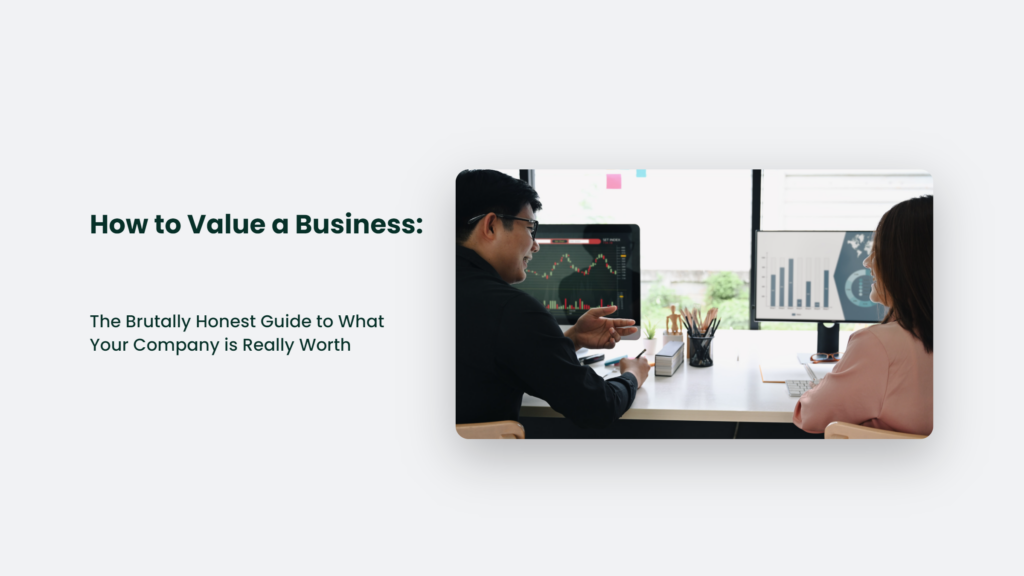

How to Value a Business: The Brutally Honest Guide to What Your Company is Really Worth

As Seen On
Figuring out how much your business is worth can be a daunting task. There are dozens of different valuation methods, each with its assumptions and limitations. And let’s be honest – most business owners have yet to learn what they’re doing regarding valuations. They just pick some arbitrary multiple of profits or revenue that sounds reasonable and hope for the best.
In this brutally honest guide, I will walk you through the key factors that drive business value. I’ll explain the most common valuation methodologies in plain English and when you should (and shouldn’t) use them. By the end, you’ll have a solid grasp of what your company is really worth – and what levers you can pull to increase that value over time.
So grab a stiff drink, and let’s get started. It ain’t going to be pretty. But let’s figure out How to value a business

The Three Pillars of Business Value
When it comes to valuing a business, three core pillars matter:
- Cash flow
- Risk
- Growth
These are the fundamental drivers of value. Master these three, and you’ll be ahead of most other business owners trying to value their company.
Cash Flow is King
The value of a business is based on its ability to generate cash. The more cash a business can produce, the more an investor will pay.
Earnings don’t mean jack. Accounting games can easily manipulate net income. The only thing that matters is cold, hard cash.
Specifically, you want to look at the business’s maintainable cash flow. It is the ongoing cash flow the business can generate after paying all expenses necessary to operate the business.
Maintainable cash flow excludes one-time revenues or expenses and accounts for necessary capital investments to generate cash in future years.
Risk Matters
The lower the risk in maintaining cash flows, the higher the valuation.
Factors that increase risk include:
- Reliance on a single customer, supplier, or employee
- Undifferentiated products with lots of competition
- Low barriers to entry into the industry
Factors that decrease risk include:
- Diversified customer base with recurring revenue
- Unique products protected by patents or trademarks
- High switching costs for customers
A predictable, recurring revenue stream will be valued much higher than a volatile, commodity business.
Growth Drives Value
The final pillar is growth potential. The faster a company can grow its cash flows, the higher its value. Imagine two companies, A and B. They both produce $1 million of maintainable cash flow today.
Company A is growing at 20% per year. Company B is stagnant with no growth.
Which would you pay more for?
Obviously, company A has a much higher upside value from its growth.
High growth signals untapped potential and future cash flow expansion. Investors will pay up for growth.
Okay, now that we’ve covered the key drivers of value, let’s look at how actually to estimate what your business is worth…
How to Value a Business: The 4 Methods
There are four main methods used to value a private business:
- The Market Approach
- The Income Approach
- The Asset Approach
- The Venture Capital Method
Each has pros and cons for different situations. Here’s a quick overview:
The Market Approach
This method values your company based on multiples from recent transactions of similar businesses. For example, you can look at the sale price divided by EBITDA or revenue from other deals to benchmark your own multiple.
Pros:
- Based on actual market evidence, not estimates
- Simple to calculate
Cons:
- It is hard to find perfect “comparable” sales
- Market prices fluctuate over time
Best for: Mature businesses with several good comparable sales
The Income Approach
This method estimates value based on the future cash flow the business is expected to generate.
The maintainable cash flow is forecasted for future years and discounted back to today’s value using a required rate of return.
Common income approach methods include Discounted Cash Flow (DCF) analysis and the Multiple of Discretionary Earnings (SDE) technique.
Pros:
- Directly values future cash flow potential
- Allows factoring risk and growth into valuation
Cons:
- Depends heavily on cash flow projections
- Requires estimating discount rate/multiple
Best for: Asset-light businesses with stable cash flows
The Asset Approach
This method totals up all the business’s assets and subtracts its liabilities to derive value.
Assets may include real estate, inventory, equipment, and intangible assets like brands or patents.
Pros:
Simple balance sheet calculation
Cons:
- Doesn’t account for future earnings potential
- Many assets like brands are hard to value
Best for: Capital-intensive businesses like manufacturers
The Venture Capital Method
This approach values early-stage companies based on the expected future value at exit.
The potential exit proceeds in 3-7 years are estimated and discounted back to today’s value.
Pros:
- Matches valuation logic of VC investors
- Values growth potential directly
Cons:
- Highly speculative exit values
- Very sensitive to assumptions/projections
Best for: Pre-revenue or early-stage startups
Okay, let’s move on to some tips for applying these valuation methods…
5 Tips for Accurately Valuing Your Business
No matter what valuation approach you use, here are five tips to ensure you get an accurate business valuation:
Use Multiple Methods
Each valuation method has pros and cons. Get a range of values by using 2-3 different methods.
It will account for the limitations of any single approach.
Normalize Cash Flows
“Normalize” cash flows by removing one-time or non-recurring expenses or revenues.
You want to value based on maintainable cash flow in an average year.
Carefully Project Growth
Don’t be overly optimistic with growth projections. Use historical growth rates unless you have very concrete plans to accelerate growth.
Account for Risk
Apply a discount rate or lower multiple for higher risk levels in the business.
Be conservative – it is better to be pleasantly surprised than disappointed!
Get Professional Help
Consider hiring a professional business appraiser, especially for large or complex valuations.
It’s worth the investment to get an independent, expert valuation.
Okay, let’s move on to some common mistakes to avoid…
3 Common Business Valuation Mistakes
It’s easy to botch your business valuation if you need to know what you’re doing. Here are some big mistakes to avoid:
Using the Wrong Valuation Method
Different methods apply better to different businesses. Don’t just default to a multiple of EBITDA if your business doesn’t produce EBITDA!
Not Normalizing Cash Flows
One-time revenues, expenses, or owner’s compensation must be adjusted to reflect maintainable cash flow.
Failing to Account for Risk
All else equal, higher-risk businesses should have lower valuations. Pay attention to risk factors!
How Much is Your Business Worth?
Let’s do a quick case study to see how you can calculate business value in the real world.
Imagine you own a medical billing company with the following stats:
- Annual revenue of $2 million
- Annual EBITDA of $400,000
- Minimal capital expenditure requirements
- Steady 10% annual revenue growth over the last 5 years
You’re interested in selling in the next year or two. How much is your business worth?
Here’s how you can arrive at a valuation:
Market Approach
Lookup recent sales of similar medical billing firms. You find they sold for 3-5x annual revenue.
Your revenue multiple valuation range is, therefore:
- Low end: $2M * 3 = $6M
- High end: $2M * 5 = $10M
Income Approach
Forecast 10% growth for the next five years. Apply industry multiple of 4x EBITDA.
Discounted back at 25% required return gives a valuation of ~$7M.
Conclusion
Based on multiple approaches, your business is likely worth $7-8M as a reasonable estimate.
This case illustrates how using a blend of different methods can give you confidence in your valuation.
Frequently Asked Questions:
How do you project future cash flows?
Future cash flows should be carefully estimated based on historical growth rates and concrete expansion plans. One-time revenues/expenses should be removed to determine maintainable cash flow. Avoid being overly optimistic in projections.
Should a business owner get professional help with the valuation?
For large or complex valuations, hiring a professional business appraiser can provide an independent, expert perspective on value. They can ensure proper methodology and help avoid mistakes. For smaller businesses, doing your own valuation is likely sufficient.
What mistakes should be avoided in a valuation?
Common mistakes include using the wrong valuation method for the business, failing to normalize cash flows properly, not accounting for risk accurately, and relying too heavily on a single approach. Avoid optimism bias and use hard data.
Key Takeaways
Here are the core lessons for accurately valuing your business:
- Cash flow, risk, and growth drive value
- Use multiple methods to triangulate on a valuation range
- Carefully project maintainable cash flows
- Apply lower multiples/discount rates for higher-risk
- Get help from a professional appraiser for large valuations
Business valuation is equal parts art and science. By understanding the key value drivers and avoiding common mistakes, you can land on a reasonable valuation range for your company.
What matters most isn’t the exact valuation number – it’s identifying the levers that will enhance your business value over time. Ultimately, you want to focus on boosting sustainable cash flows and reducing risk.
So be honest, avoid optimism bias, and make data-driven decisions to maximize your business value. Those are the keys to getting top dollar when it comes time to cash out!
Konger
Up until working with Casey, we had only had poor to mediocre experiences outsourcing work to agencies. Casey & the team at CJ&CO are the exception to the rule.
Communication was beyond great, his understanding of our vision was phenomenal, and instead of needing babysitting like the other agencies we worked with, he was not only completely dependable but also gave us sound suggestions on how to get better results, at the risk of us not needing him for the initial job we requested (absolute gem).
This has truly been the first time we worked with someone outside of our business that quickly grasped our vision, and that I could completely forget about and would still deliver above expectations.
I honestly can't wait to work in many more projects together!
Disclaimer
*The information this blog provides is for general informational purposes only and is not intended as financial or professional advice. The information may not reflect current developments and may be changed or updated without notice. Any opinions expressed on this blog are the author’s own and do not necessarily reflect the views of the author’s employer or any other organization. You should not act or rely on any information contained in this blog without first seeking the advice of a professional. No representation or warranty, express or implied, is made as to the accuracy or completeness of the information contained in this blog. The author and affiliated parties assume no liability for any errors or omissions.

